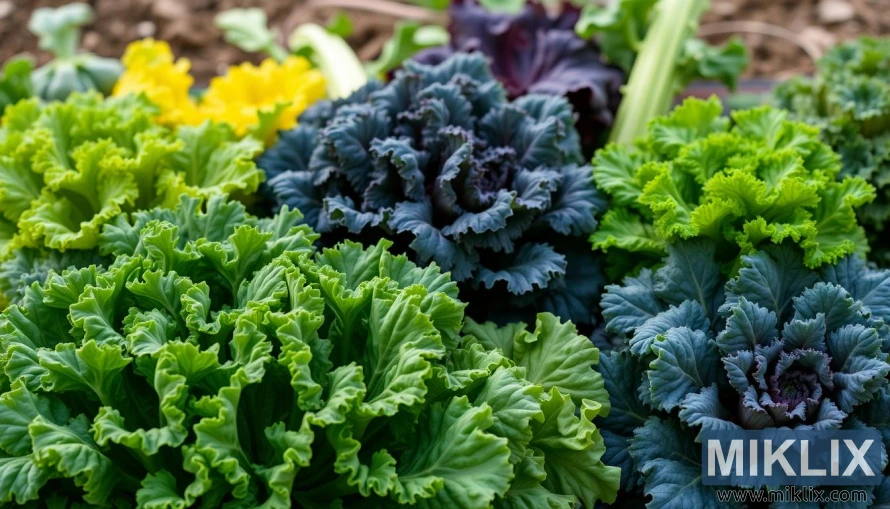Image: Vibrant Kale Varieties on a Natural Backdrop
Published: March 26, 2025 at 6:12:33 PM UTC
Last updated: September 23, 2025 at 8:51:07 PM UTC
Artful arrangement of curly green, purple lacinato, yellow-green Russian, and baby kale with ribbed stems, softly lit against a blurred, organic backdrop.
The image captures an exquisite and richly textured display of kale varieties, arranged in a natural setting that emphasizes both their beauty and vitality. At first glance, the viewer is drawn to the lush, curly kale in the foreground, its leaves a brilliant green with ruffled edges that seem almost sculptural. Each fold and curve of the foliage catches the light in subtle ways, giving the plant a vibrant energy and making the greens appear alive with freshness. The delicately serrated surfaces shimmer softly under diffused natural lighting, evoking the sense of leaves just kissed by morning dew. The density of the kale’s structure, combined with its deeply veined leaves, creates an impression of strength and resilience, qualities that mirror its reputation as a hardy, nutrient-dense vegetable.
Surrounding the central green kale is a symphony of other varieties, each contributing its own personality to the arrangement. Deep purple kale with its dramatic, velvety leaves provides a striking contrast, the rich hues bordering on indigo and nearly black in the shadows. This darker variety seems to anchor the composition, lending depth and a sense of grounding to the vibrant display. Interspersed among them are lighter, yellow-green varieties, their brightness suggesting youth and delicacy, as though freshly sprouted from the soil. These contrast beautifully with the emerald tones of tender baby kale, their softer forms hinting at the gentle sweetness they bring when compared to the more robust bite of mature leaves. Together, the collection resembles a living tapestry of color, texture, and form, each variety harmonizing with the others while also standing out in its own distinct way.
The middle ground draws attention to the kale stalks, sturdy and ribbed, offering a visual counterpoint to the frilled leaves. Their upright growth and firm appearance suggest durability, while also reminding the viewer of kale’s agricultural heritage, rooted deeply in the soil and thriving across seasons. These stems reinforce the vegetable’s association with endurance and nourishment, qualities that have made kale a staple in cuisines across cultures. They also add structure to the arrangement, creating vertical lines that balance the wide, sprawling leaves.
In the background, a gentle blur of earthy soil and surrounding foliage creates a natural frame for the vibrant kale. The muted backdrop serves to highlight the colors in the foreground, allowing the greens, purples, and yellows to stand out with even greater intensity. This subtle setting situates the kale within its natural environment, emphasizing its role as both a cultivated crop and a living element of the earth’s seasonal rhythms. The soil hints at fertility and continuity, reinforcing the connection between land, plant, and nourishment.
What makes the image especially captivating is the interplay of light and shadow. Soft, diffused sunlight filters through, illuminating the kale in a way that brings out the intricacy of its textures. Highlights shimmer along the ruffled edges, while deeper shadows within the folds of the leaves create a sense of depth and dimension. This dynamic interplay enhances the kale’s sculptural quality, making it appear almost three-dimensional, as though the viewer could reach out and feel the crispness of the leaves. The lighting lends the entire scene a freshness that suggests vitality and abundance, while also imbuing it with a quiet, timeless beauty.
Beyond its visual appeal, the image subtly conveys the nutritional and symbolic significance of kale. Often celebrated as a “superfood,” kale is packed with vitamins, minerals, and antioxidants, and its robust leaves have come to symbolize health and vitality in contemporary food culture. Its presence in the image—thriving, colorful, and abundant—echoes these associations, portraying kale not just as a vegetable but as a representation of natural nourishment and well-being. The variety of colors and forms reminds us of the diversity of nutrients it offers, while the sturdy stalks and vigorous leaves reflect its resilience as a crop.
Altogether, this vibrant arrangement of kale varieties is more than a simple depiction of vegetables. It is a visual celebration of growth, diversity, and abundance. The interplay of colors, the sculptural ruffles of the leaves, the earthy grounding of the stems and soil, and the soft, life-giving light all combine to elevate kale from a humble leafy green into a symbol of vitality, freshness, and the enduring bond between humans and the natural world.
The image is related to: Green Gold: Why Kale Deserves a Spot on Your Plate

